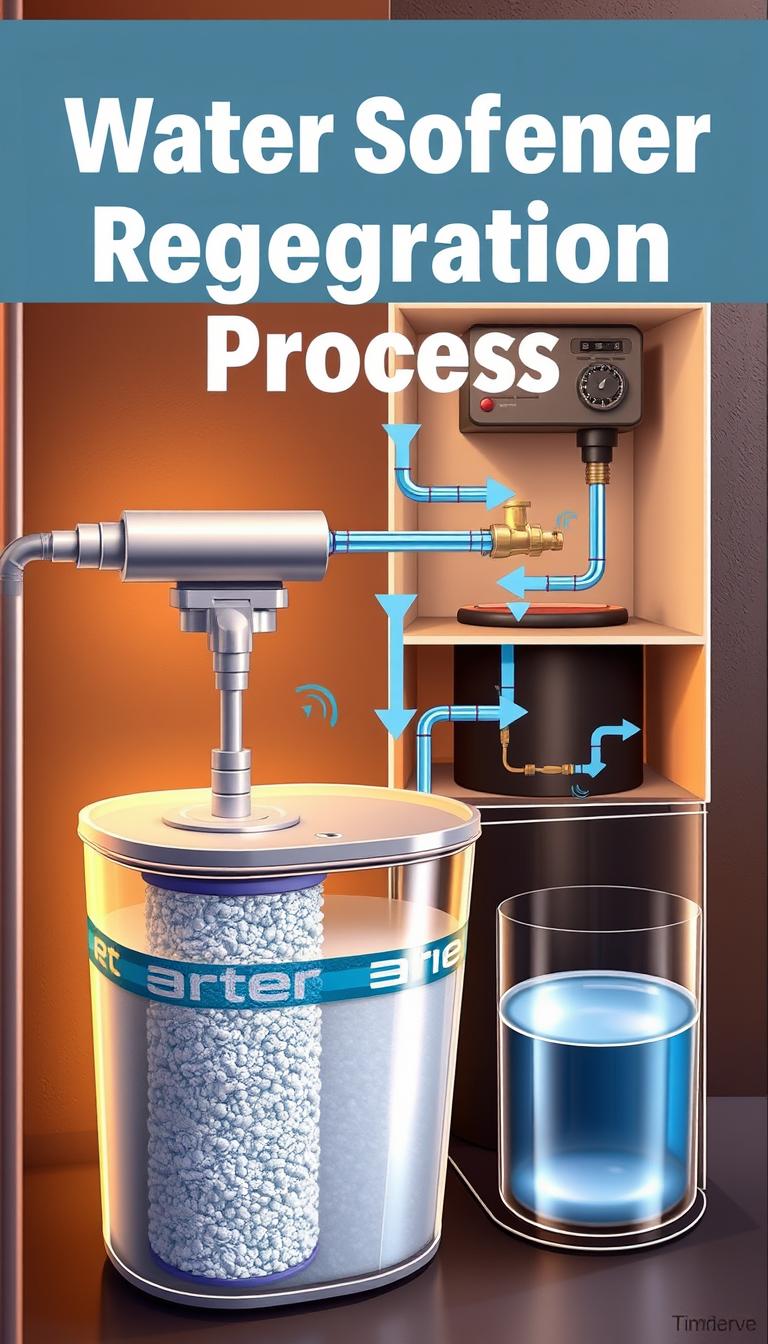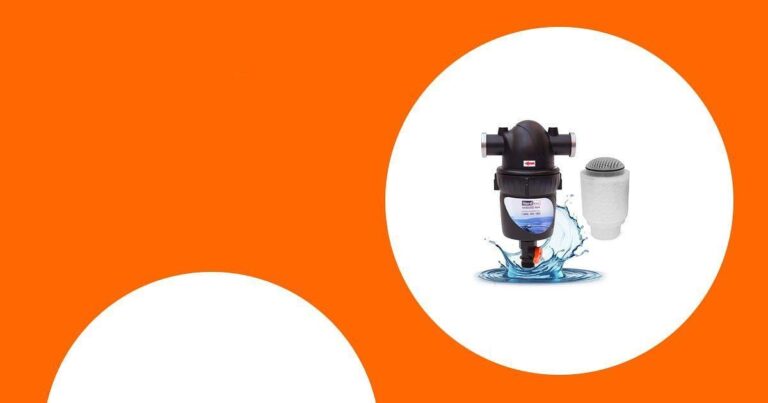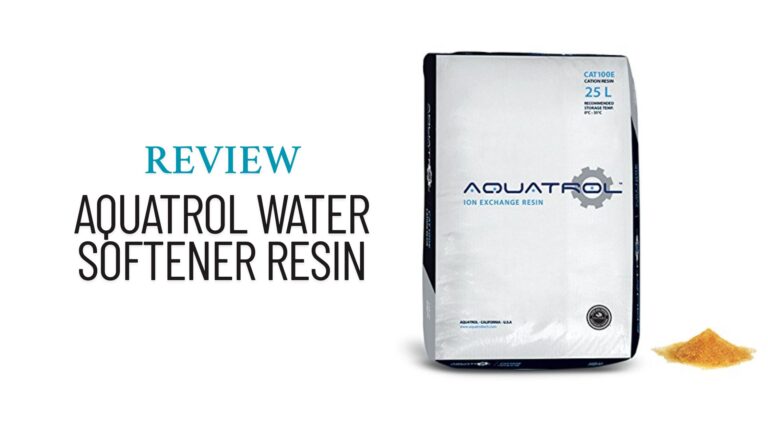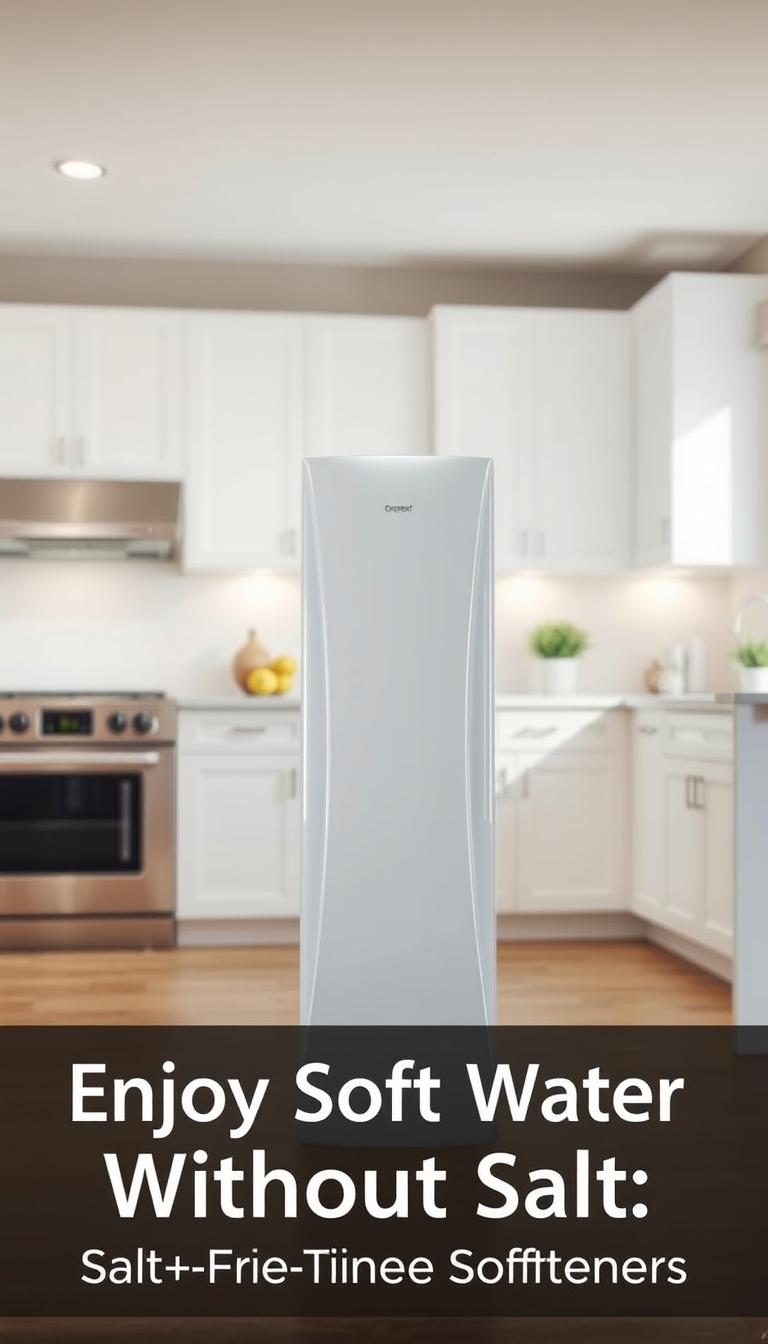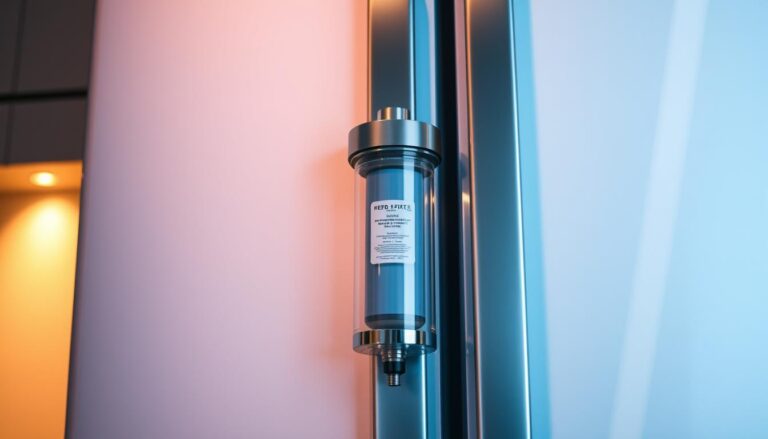Regeneration: How Home Water Softeners Work
Have you ever wondered how your home water softener continues to provide soft, clean water despite the constant flow of hard water into it? The secret lies in the water softener regeneration process, a critical component that ensures the effectiveness of your water softener.
The regeneration cycle is necessary to clean the resin beads that collect hardness minerals from tap water, allowing your water softener to function optimally. Understanding this process can help you appreciate the importance of maintaining your water softener.
By grasping how the water softener regeneration process works, you can ensure your home water softener continues to provide the soft, clean water you need.
Key Takeaways
- Water softener regeneration is crucial for maintaining soft, clean water.
- The regeneration cycle cleans resin beads that collect hardness minerals.
- Understanding regeneration helps appreciate water softener maintenance.
- Regular regeneration ensures optimal water softener performance.
- Proper maintenance can extend the lifespan of your water softener.
The Hidden Culprit: Hard Water in American Homes
Hard water, characterized by its high mineral content, is a common issue affecting numerous homes across the United States. The primary minerals responsible for water hardness are calcium and magnesium, which are absorbed as water passes through rocks and soil.
What Makes Water “Hard”?
Water becomes “hard” when it contains high levels of these minerals. The degree of hardness is measured in terms of the amount of calcium carbonate equivalent in the water. High levels of calcium and magnesium lead to what is known as hard water, which can cause scaling in pipes and appliances.
Signs Your Home Has Hard Water Problems
Several signs indicate the presence of hard water in a home. These include soap not lathering properly, spots on dishes and glasses, and scaling on appliances and plumbing fixtures. If you notice these issues, it may be a sign that you have hard water.
Understanding the causes and signs of hard water is crucial for determining the appropriate solution, such as installing a water softener. By addressing hard water, homeowners can prevent damage to their appliances and plumbing systems, and improve the overall quality of their water.
How Water Softeners Transform Hard Water
By utilizing the ion exchange process, water softeners can significantly improve the quality of water in homes. This process is fundamental to understanding how water softeners work.
The Ion Exchange Process Explained
The ion exchange process involves replacing calcium and magnesium ions, which cause water hardness, with sodium ions. This is achieved through resin beads in the water softener that attract and hold the calcium and magnesium ions.
Key Components of a Home Water Softener System
A home water softener system consists of several key components that work together to soften water.
Resin Tank: Where the Magic Happens
The resin tank is where the ion exchange process takes place. It contains resin beads that attract and hold calcium and magnesium ions.
Brine Tank: The Salt Storage Solution
The brine tank stores salt, which is used to recharge the resin beads. The salt is dissolved in water to create a brine solution that is used to regenerate the resin.
Control Valve: The System’s Command Center
The control valve is responsible for managing the water softener’s operation, including the regeneration cycle. It ensures that the system operates efficiently and effectively.
Understanding these components and how they work together is crucial for maintaining a water softener system.
What is Regeneration in a Home Water Softener?
Regeneration is a crucial process in the operation of a home water softener, ensuring it continues to remove calcium and magnesium ions effectively. This process is essential for maintaining the water softener’s efficiency and prolonging its lifespan.
The Definition and Critical Purpose of Regeneration
Regeneration is defined as the process by which a water softener cleans and recharges its resin beads. During regeneration, the system flushes the resin with a saltwater solution, removing the accumulated calcium and magnesium ions that cause water hardness. This process is critical because it allows the water softener to continue functioning effectively, providing soft water for household use.
Why Softener Resin Eventually Needs Refreshing
Over time, the resin beads in a water softener become saturated with calcium and magnesium ions, reducing their ability to soften water. Regeneration refreshes these resin beads by removing the accumulated ions, allowing them to continue exchanging sodium ions for calcium and magnesium ions. Without regular regeneration, the water softener’s effectiveness diminishes, leading to hard water issues.
The Consequences of Skipping Regeneration
Skipping regeneration can have several negative consequences, including reduced water softener effectiveness, increased energy consumption, and potential damage to the softener itself. When the resin is not regularly refreshed, it can become fouled, leading to a decrease in water quality and potentially causing problems with appliances that rely on soft water. Regular regeneration is essential to avoid these issues and ensure the water softener operates at peak performance.
Inside the Regeneration Cycle: A Step-by-Step Breakdown
Understanding the regeneration cycle is key to appreciating how water softeners maintain their effectiveness over time. The regeneration cycle is a complex process that involves several critical stages to rejuvenate the water softener’s ability to soften water.
Backwash: Flushing the Resin Bed
The regeneration cycle begins with the backwash stage, where water flows through the resin bed in the opposite direction of normal service. This process dislodges accumulated debris and sediment, ensuring the resin beads remain effective in softening water.
Brine Draw: Recharging with Sodium Ions
Following backwash, the brine draw stage involves drawing a concentrated brine solution into the resin tank. This brine solution recharges the resin beads with sodium ions, which are essential for the ion exchange process that softens water.
Slow Rinse: Maximizing Salt Efficiency
The slow rinse stage is crucial for maximizing the efficiency of salt usage. During this phase, water slowly flows through the resin bed, allowing the sodium ions to be evenly distributed and ensuring that the resin is fully recharged.
Fast Rinse: Preparing for Service
After the slow rinse, the fast rinse stage prepares the water softener for normal operation. This stage involves a rapid flow of water through the resin bed to remove any remaining brine solution and ensure the water softener is ready for service.
Brine Tank Refill: Setting Up the Next Cycle
The final stage of the regeneration cycle is the brine tank refill. During this stage, water is added to the brine tank to create a new brine solution for the next regeneration cycle, ensuring the water softener is always ready to soften water.
In conclusion, the regeneration cycle is a multi-faceted process that is vital for the optimal functioning of a water softener. By understanding each stage, homeowners can better appreciate the complexity and importance of their water softening system.
Different Regeneration Triggers and Timing Methods
Understanding the triggers that initiate regeneration in water softeners is crucial for optimal performance. Regeneration is not a one-size-fits-all process; different systems employ various methods to determine when to regenerate.
Timer-Based Systems: The Traditional Approach
Timer-based systems were among the first methods used to trigger regeneration in water softeners. These systems regenerate the softener based on a predetermined schedule, typically set by the user or manufacturer. While straightforward, this method can lead to inefficiencies if the regeneration occurs too frequently or too infrequently for the household’s water usage.
Demand-Initiated Regeneration: The Smart Solution
Demand-initiated regeneration represents a more advanced and efficient approach. This method triggers regeneration based on the actual water usage, ensuring that the softener regenerates only when necessary. It’s a more adaptive and water-efficient solution, as it directly responds to the household’s needs.
Manual Regeneration: When and Why to Override
Manual regeneration allows users to override the automatic regeneration settings. This can be useful during periods of low water usage or when maintenance is required. Understanding when to manually initiate regeneration can help in managing the water softener’s performance during unusual circumstances.
| Regeneration Method | Description | Efficiency |
|---|---|---|
| Timer-Based | Regenerates on a fixed schedule | Moderate |
| Demand-Initiated | Regenerates based on water usage | High |
| Manual | User-initiated regeneration | Varies |
In conclusion, the choice of regeneration trigger significantly affects the performance and efficiency of a water softener. By understanding the different methods available, homeowners can make informed decisions about their water softener’s maintenance and operation.
Optimizing Your Water Softener Regeneration Cycle
To get the most out of your water softener, understanding and optimizing its regeneration cycle is essential. The regeneration frequency depends on several factors, including water hardness levels and household water usage. By adjusting the regeneration settings based on these factors, you can optimize your water softener’s performance.
Calculating the Perfect Regeneration Frequency
Calculating the ideal regeneration frequency involves considering your household’s water consumption patterns and the hardness of your water supply. A general rule of thumb is to regenerate your water softener every 7-10 days, but this can vary. For instance, if you live in an area with very hard water or have a large household, you may need to regenerate more frequently.
Adjusting Settings Based on Water Hardness Levels
Water hardness is a critical factor in determining how often your water softener should regenerate. If your water is extremely hard, your softener will need to work harder to remove minerals, thus requiring more frequent regeneration. You can adjust your softener’s settings based on the hardness level to ensure optimal performance.
Fine-Tuning for Household Size and Usage Patterns
Household size and water usage patterns also play a significant role in optimizing the regeneration cycle. Larger households or homes with higher water usage will need to regenerate more often. Monitoring your water usage and adjusting your softener accordingly can help in achieving the perfect balance. This not only ensures your water is always soft but also helps in conserving salt and water.
By carefully considering these factors and making the necessary adjustments, you can optimize your water softener’s regeneration cycle, ensuring it runs efficiently and effectively.
Smart Regeneration Technology: The Latest Innovations
Smart regeneration technology is revolutionizing the way water softeners operate, making them more efficient and convenient. This cutting-edge technology is transforming the water softening industry by introducing advanced features that optimize the regeneration process.
Wi-Fi Connected Water Softeners
One of the significant advancements in smart regeneration technology is the integration of Wi-Fi connectivity in water softeners. This allows users to monitor and control their water softeners remotely through smartphone apps, receiving notifications when regeneration is required or when there are issues with the system.
Predictive Regeneration Algorithms
Predictive regeneration algorithms are another innovation that is enhancing the efficiency of water softeners. These algorithms analyze water usage patterns and predict when regeneration is necessary, ensuring that the system operates at optimal levels without wasting resources.
Water and Salt Efficiency Breakthroughs
Smart regeneration technology has also led to significant breakthroughs in water and salt efficiency. Modern water softeners can now optimize salt usage and minimize water consumption during regeneration, making them more environmentally friendly and cost-effective.
| Feature | Traditional Systems | Smart Regeneration Systems |
|---|---|---|
| Wi-Fi Connectivity | No | Yes |
| Predictive Regeneration | No | Yes |
| Water Efficiency | Low | High |
| Salt Efficiency | Low | High |
The Real Benefits of Proper Water Softener Regeneration
The benefits of proper water softener regeneration extend far beyond just softer water. By regenerating your water softener correctly, you can enjoy a range of advantages that improve your home’s comfort, efficiency, and overall quality of life.
Extended Appliance Lifespan and Performance
Proper regeneration helps maintain your water softener’s performance, which in turn extends the lifespan of your appliances. By reducing scale buildup, you’ll protect your plumbing and appliances from damage, ensuring they operate efficiently for longer. For more information on how water softeners work, you can visit Culligan Water Softeners 101.
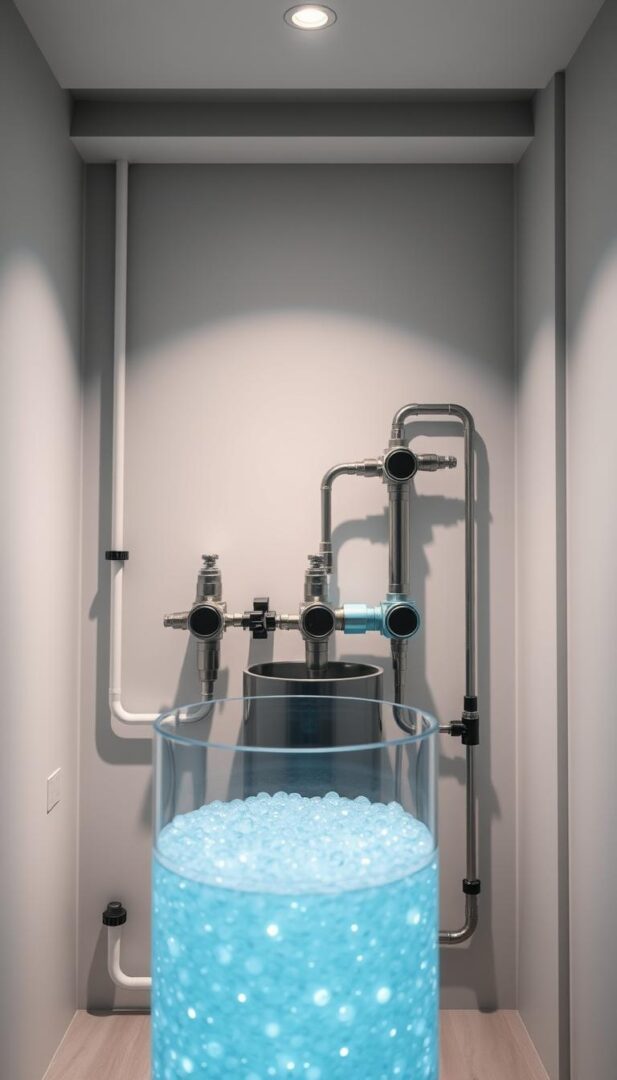
Reduced Energy Consumption and Utility Bills
A well-maintained water softener, through regular regeneration, can help reduce energy consumption. By removing scale buildup, you’ll improve the efficiency of your water heater and other appliances, leading to lower utility bills.
Improved Cleaning Results and Reduced Detergent Usage
Soft water, maintained through proper regeneration, makes cleaning easier and more effective. You’ll notice improved cleaning results and can reduce your detergent usage, as soft water is more efficient at cleaning.
Better Feeling Skin and Hair
Soft water is gentler on skin and hair, leaving you with a softer, healthier feel. By regenerating your water softener correctly, you can enjoy these personal hygiene benefits daily.
Troubleshooting Common Regeneration Problems
To keep your water softener running smoothly, it’s vital to identify and fix regeneration problems promptly. Regeneration is a critical process that rejuvenates the softener’s ability to remove minerals from hard water. However, issues can arise that affect its efficiency.
Salt Bridges and Mushing in the Brine Tank
A common issue during regeneration is the formation of salt bridges or mushing in the brine tank. Salt bridges occur when a solid layer of salt forms, preventing the salt below it from dissolving. Mushing happens when salt dissolves into a dense, impenetrable mass. To fix this, break up the salt bridge or mush with a broom handle or similar tool, ensuring the salt can dissolve properly.
Resin Bed Fouling and Cleaning Solutions
Resin bed fouling is another problem that can occur, often due to iron or other contaminants in the water. This can lead to reduced softener efficiency. Cleaning the resin bed involves using a resin cleaner or a specific product designed to remove fouling agents. Regular maintenance can help prevent severe fouling.
Control Valve Malfunctions and Repairs
The control valve is a crucial component of the water softener, regulating the regeneration cycle. Malfunctions can lead to improper regeneration. Checking the valve for blockages, misalignments, or worn-out parts can often resolve the issue. In some cases, replacing the control valve may be necessary.
Water Leaks During Regeneration
Water leaks during regeneration can indicate a problem with the softener’s plumbing or the control valve. Inspecting the system for loose connections or damaged seals can help identify the source of the leak. Tightening or replacing the affected parts should stop the leak.
| Issue | Cause | Solution |
|---|---|---|
| Salt Bridges/Mushing | Solid salt layer or dense mass | Break up salt bridge/mush |
| Resin Bed Fouling | Iron or contaminants | Use resin cleaner |
| Control Valve Malfunction | Blockages, misalignment | Inspect and repair/replace valve |
By understanding and addressing these common regeneration problems, you can ensure your water softener continues to function effectively, providing you with soft, clean water.
Essential Maintenance for Optimal Regeneration
Optimal regeneration of your water softener depends on consistent and proper maintenance. Regular upkeep ensures that your system continues to provide softened water efficiently, protecting your appliances and plumbing from the damaging effects of hard water.
Monthly and Quarterly Maintenance Checklist
To keep your water softener in top condition, it’s essential to perform routine checks and tasks. Monthly, inspect the brine tank for salt levels and signs of salt bridging or mushing. Quarterly, check the condition of the resin and consider cleaning or replacing it if necessary. For detailed guidance, refer to resources like water softener maintenance guides.
Proper Salt Selection and Loading Techniques
Choosing the right salt for your water softener is critical. High-purity salt is recommended to prevent residue buildup in the brine tank. When loading salt, avoid overfilling the tank, as this can lead to salt bridging. Use salt specifically designed for water softeners to ensure optimal performance.
Cleaning the Brine Tank and Venturi Valve
Periodically cleaning the brine tank and venturi valve is crucial for maintaining your water softener’s efficiency. Remove any debris or sediment from the brine tank and inspect the venturi valve for blockages. Cleaning these components regularly can prevent issues with regeneration.
When to Call a Professional
If you encounter persistent problems with your water softener, such as recurring salt bridging or inadequate softening, it may be time to consult a professional. Experts can diagnose and fix complex issues, ensuring your system operates effectively.
The Cost Factor: Economic Considerations of Regeneration
The economic aspects of water softener regeneration, including salt expenses and energy costs, are vital to consider. Regeneration is not just a necessary process for maintaining water quality; it also comes with its own set of costs that can impact household budgets.
Salt Expenses and Usage Rates
One of the primary expenses associated with water softener regeneration is the cost of salt. The rate at which salt is consumed depends on several factors, including the hardness of the water, the size of the household, and the efficiency of the water softener. Efficient salt usage can be achieved by selecting the right type of salt and ensuring the softener is properly maintained.
Water Consumption During Regeneration Cycles
Regeneration cycles also consume water, which can contribute to overall water usage. Modern water softeners are designed to be more water-efficient, but the amount of water used can still vary. Understanding the water consumption patterns during regeneration can help households manage their water usage more effectively.
Energy Costs Associated with Regeneration
While the primary energy consumption of a water softener is typically low, some models, especially those with advanced features like Wi-Fi connectivity, may consume more energy. It’s essential to consider the energy efficiency of the water softener when evaluating overall costs.
Long-term Savings from Proper Maintenance
Proper maintenance and efficient regeneration practices can lead to significant long-term savings. By extending the lifespan of appliances, reducing detergent usage, and lowering energy bills, households can offset the costs associated with regeneration. Regular maintenance is key to ensuring the water softener operates efficiently.
In conclusion, while regeneration comes with its costs, understanding and managing these expenses can help households make the most of their water softener systems.
Conclusion: Mastering Your Water Softener for Peak Performance
Mastering the regeneration process and maintaining your water softener properly can ensure peak performance and longevity of the system. By understanding how your water softener works and implementing the right regeneration cycle, you can enjoy the benefits of softened water while minimizing energy consumption and utility bills.
To achieve peak performance, it’s essential to optimize your water softener’s regeneration cycle based on your household’s size and usage patterns. Regular maintenance, including cleaning the brine tank and checking for salt bridges, will also help to maintain your system’s efficiency.
By applying the knowledge gained from this article, you can take control of your water softener’s performance and enjoy the benefits of softened water for years to come. Effective regeneration and maintenance will not only improve your water softener’s peak performance but also extend its lifespan, providing you with a reliable and efficient solution for your water softening needs.

